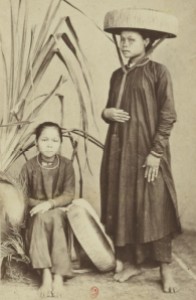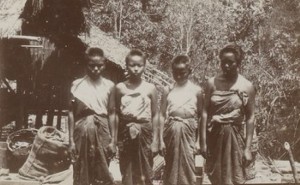As the field of Southeast Asian Studies developed (particularly in North America and Australia) in the second half of the twentieth century, one of the ideas that came to be established as a defining feature of Southeast Asia as a region was the idea that traditionally women in Southeast Asia were “better off” or “more autonomous” than women in other parts of the world, particularly in East and South Asia.
A Google search for “women in Southeast Asia,” easily brings up information which is representative of that interpretation:
“The 11 countries of Southeast Asia include over 550 million people. Despite great linguistic and cultural diversity, the region is characterized by the relatively favorable position of women in comparison with neighboring East or South Asia.
“This has been explained by several factors: traditionally, kinship was traced though both maternal and paternal lines; a daughter was not a financial burden because of the widespread practice of bride price; a married couple often lived with or near the wife’s parents; women had prominent roles in indigenous ritual; their labor was essential in agricultural [work], and they dominated local markets.
“Over time, however, the rise of centralized states and the spread of imported philosophies and religions (Confucianism, Daoism, Buddhism, Islam, and Christianity) increasingly privileged males and stressed female subordination. Although such influences were most noticeable among the elite, the strength of local traditions was always a moderating force.”
This characterization of Southeast Asia was created largely by scholars from outside the region, and by using sources that were written by people from outside the region. In particular, scholars who have tried to characterize “traditional” Southeast Asia have relied heavily on the writings of European travelers to the region, and there is a good reason for doing so.
As Anthony Reid points out in the opening passages of Southeast Asia in the Age of Commerce, Europeans wrote about things that people in the region did not record (like how they ate). Such things were too obvious to local people to need to write about. However, to Europeans they were interesting because they were different from what existed in their own societies.
In talking about places that were different from their own societies, early European travelers to Southeast Asia of course viewed what they saw with a certain degree of bias, and that is something which scholars in the second half of the twentieth century sought to ignore, or to “read through the lines” in order to see something closer to “the truth.”
But how do we know what is a bias and what is not?
I was thinking about this characterization of the status of women in traditional Southeast Asia and the kinds of sources that were used to create that characterization recently as I was reading a book entitled China Pictorial, Descriptive, and Historical, with some account of Ava and the Burmese, Siam and Anam. Published in 1853, this book was largely written by a certain Julia Corner, but the parts at the end about Burma, Siam and Annam were attributed to “a gentleman who was devoted much time to the study of China and the Indo-Chinese nations.”
This is what this gentleman had to say about women in Annam:
“. . . the women of Annam are treated with very little respect or tenderness. Provided he do not kill her outright, her husband may inflict the severest corporal punishment upon his wife without being called to any account, and without forfeiting the good opinion of his neighbors.
“The gentlemen of our mission were constantly annoyed by the cries of poor women, and by the sight of husbands publicly bambooing their wives.
“An Annamese boatman told an American trader that wives require a great deal of caning, – that nothing but the bamboo could keep them in proper discipline and order.” (327)
As far as I know, none of the “imported philosophies” of Daoism, Buddhism and Confucianism that were part of the cultural mix of Annam/Vietnam at that time have much to say about the importance of beating women, but perhaps one could make an argument that Buddhism and Confucianism do privilege men.
However, do they do so to the extent that they could transform a society from one in which men did not beat their wives to one in which they did beat their wives?
Or perhaps no one was getting beaten, and this information about women getting caned and bambooed was simply this author’s invention and represents his bias? If that is the case, then how can we know that?
This same author also talked about the work that women did in Annam and Siam. This is what he said about Annam:
“. . . a large amount of the male population is absorbed by the army and other services of government, the women of the poorer classes have an uncommon share of hard work.
“It is, indeed, often said, that in this country the labor of the women supports the men. They plough, harrow, reap, and carry heaven burdens; and they are also shopkeepers, pedlers, brokers, and money-changers.” (328)
And this is what the author wrote about Siam:
“Like the women of the poor in Cochin-China, the poor females in Siam perform all manner of hard labor, and for the same reason – so many of the men are taken from their own work by the heavy military conscription. They row the boats, carry burdens, plough, sow, and harrow.” (387)
From these passages it is clear that women’s labor was “essential” for agriculture, and we can get a sense that they “dominated” the markets, but this author did not describe that fact in positive terms.
Instead, from his perspective the fact that women were working in the fields and trying to make money in the market was connected to the fact that they were living in a society where their husbands were being exploited by the state, and could not support their families.
So from that perspective, can we say that the centralized states of Siam and Annam were privileging men and suppressing women? Or would it be more accurate to say that these states suppressed poor men and left poor women to find their own means to survive?
To be fair, many scholars today (particularly those who have long studied this matter) realize that the lives of women in premodern Southeast Asia were not as rosy as they were originally depicted by scholars in the second half of the twentieth century.
However, when I read passages like the ones above, I continue to feel that the way we write about the past today is still much too “favorable.”
Many societies in the past (all over the world) were oppressive and exploitative. That, however, is a point which, scholars in the second half of the twentieth century downplayed. Writing in the immediate post-colonial era, scholars were eager to return some dignity to people in Southeast Asia by characterizing Southeast Asian societies differently from the ways that some colonial-era scholars had done – that is, by emphasizing the “strengths” of Southeast Asian societies, rather than their “weaknesses.”
Women were seen as one of the strengths of Southeast Asian societies. But perhaps in reality their “favorable position” had a lot to do with the weaknesses of Southeast Asian states.
Whatever the case may be, it’s always good to go back to the sources that scholars base their arguments on and rethink the issues that they talked about.





